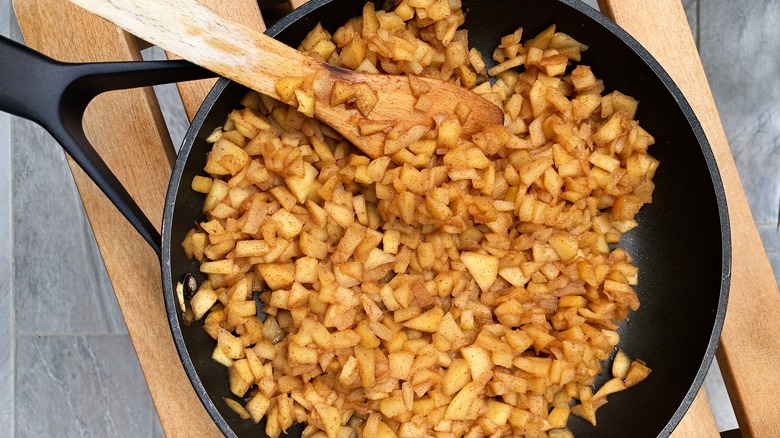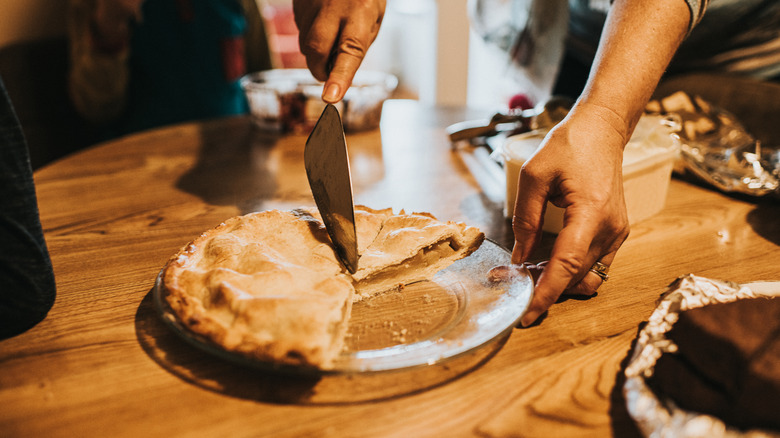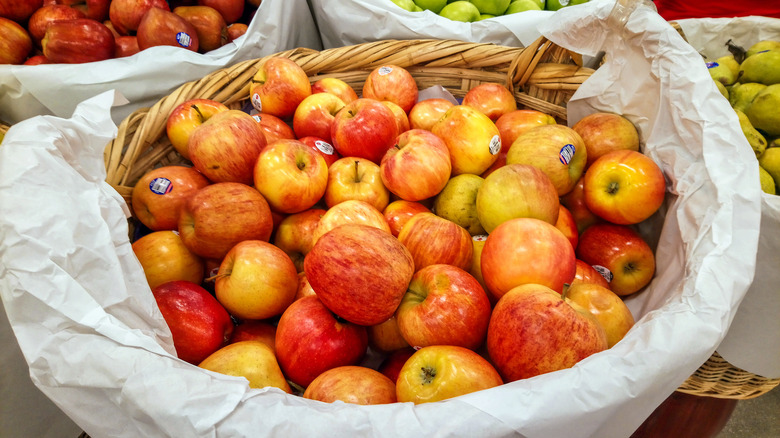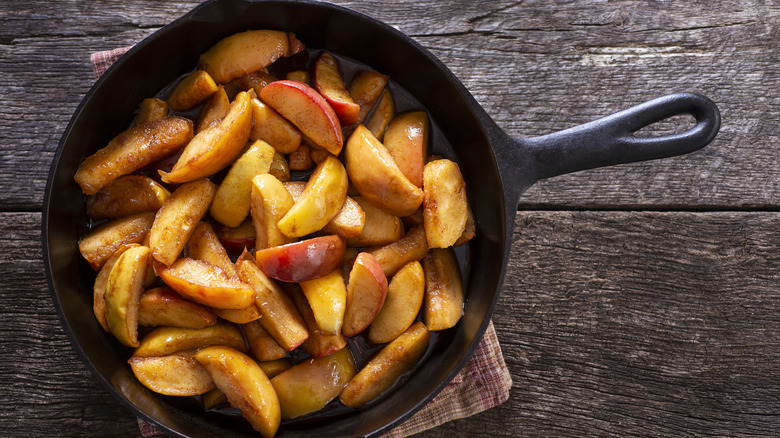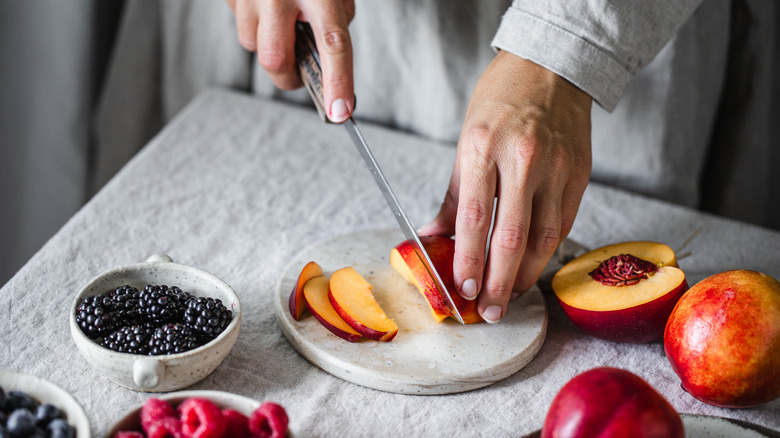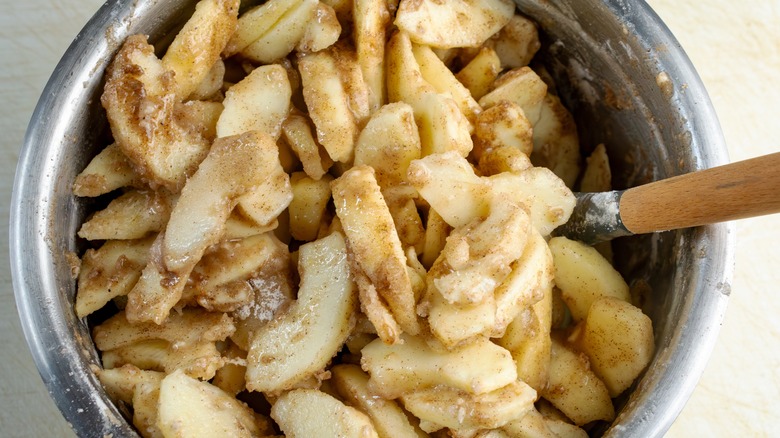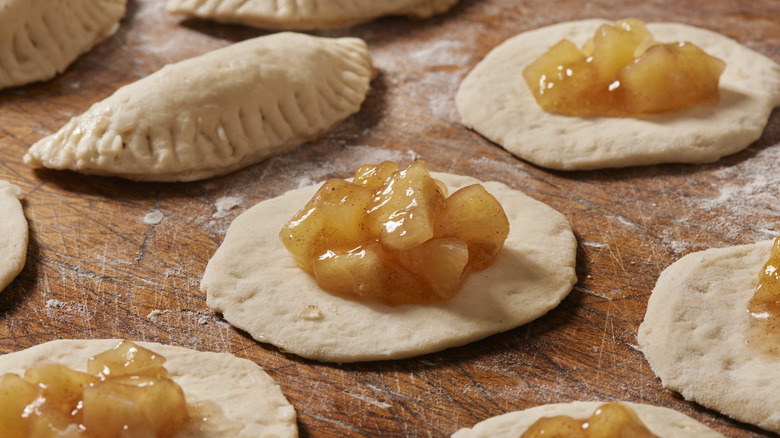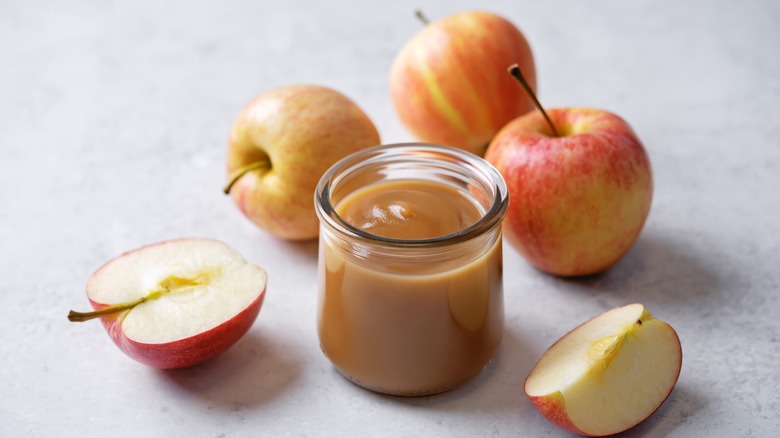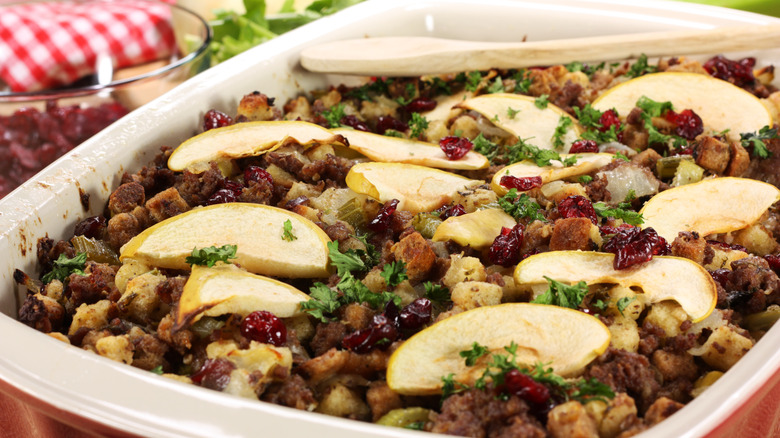8 Tips For Making The Perfect Homemade Apple Filling For Your Fall Desserts, According To Pastry Chefs
Fall is finally upon us, and there is no better way to commemorate the new season than with apple desserts. From apple crisp to apple cobbler to apple pie, there is no end to the ways you can use your favorite apples in the sweet treats you make this autumn. Plus, apple-based desserts are popular for people of all ages, so they are perfect for satisfying your parents or your kids, and they work for a casual dinner as well as a more proper Thanksgiving meal.
The key to getting your apple desserts right is focusing most of your energy on the filling, considering factors like thickness, spice level, and sweetness. If you have never made an apple filling before, or even if you have and need a refresher, this article will give you the top eight tips for perfecting an apple filling you can use in any of your desserts this season. We spoke to Raymie Fuentes, the pastry chef at Bouchon Bakery, and Paty Zamarripa, the pastry chef from Hotel Chelsea, to get the inside scoop on what chefs think are the most important things to do while making your apple filling. Here's what they said.
Make desserts with flaky dough
An apple filling can be liquidy, and in order for the dessert you are making to taste good, you will need a solid foundation for the apple filling to rest in. This is why desserts with flaky dough are best to make when you plan to use an apple filling. An example of a flaky dough dessert is using puff pastry dough to make a cinnamon roll that you top with chunks of your apple filling.
But of course, sometimes keeping it classic is the best way to go. According to Chef Raymie Fuentes of Bouchon Bakery, "There is no better vessel for a delicious apple filling like a pie shell." A good pie crust is flaky, because it gives the shell a nice crisp, buttery taste that can hold up well against any filling you put in it.
To get a flaky dough, specifically a flaky pie crust, you need two things: butter and layers. When the butter gets heated in the oven, air pockets are created in the dough, which consequently adds layers to it. These layers are what give the dough its texture, which is the first step to perfecting your fall dessert. A flaky dough will always hold an apple filling well without getting soggy or poorly textured.
Pay attention to the type of apples you use
There are many species of apples to choose from when making an apple filling — Gala, Red Delicious, Granny Smith, and Fuji are some of the classics. According to Paty Zamarripa, a pastry chef at Hotel Chelsea, the type of apple you choose will affect the taste and texture of your apple filling, so it is important to know exactly what you want your filling to taste like, and which apples are going to give you that outcome.
"A green apple is acidic, fresh, and crispy — the filling [will have] a good texture even if baked and would have a good balance of sweetness thanks to its acidity," Zamarripa said. If you are looking to have less sweetness and more balanced flavors in your apple filling, try using Granny Smith, Ginger Gold, or Pippin apples, all of which are green. On the other hand, a filling with red apples will naturally be sweeter, according to Zamarripa.
Red apples, like Red Delicious, are sweet and juicy, which Zamarripa notes will transfer to a softer and gooier apple filling. This is important, because according to Chef Raymie Fuentes of Bouchon Bakery, the different apple varieties will mostly change the mouthfeel of your filling. So, if you do not like a gooey texture, you might be better off using green apples. Whatever you want your filling to taste and feel like, you should be intentional about the apples you are using.
Try precooking your apples
The biggest mistake that could happen when making a fall apple recipe is that the doughy outside becomes too soggy to be enjoyable. Precooking the apples could help with this problem. Precooking apples eliminates any excess liquid that might get into your dough if you cooked the apples and dough together, resulting in less of a chance for sogginess.
To precook the apples, you can use a deep pot like a Dutch oven. Use any spices or sugars to season your apples that you desire, and then let the apples cook over medium heat in a covered pot for as long as it takes for them to be tender. This is a technique favored by Chef Raymie Fuentes of Bouchon Bakery. "I prefer to precook the apples prior to making the filling, as it will result in a softer apple," Fuentes said.
Another benefit to precooking your apples is that you can make your apple pie filling in advance — a perk helpful if you are making more than one dessert or prepping for a holiday meal. The filling can be stored in the fridge for a couple of days, or it can be put in the freezer until you are ready to use it. In this way, precooking the apples can both preserve the texture of your fall desserts and save you some time in the kitchen.
Utilize your best knife skills
Like always in the kitchen, putting your best skills forward is important for making the perfect apple filling. This includes your knife skills, which need to be very precise when prepping apples for an apple filling. Chef Paty Zamarripa of Hotel Chelsea recommends cutting your apples into even, medium-sized pieces.
"If we cut the apples into very small pieces, they can overcook and lose liquid and flavor," Zamarripa said. "When we cut the apple into medium pieces, the outer texture becomes soft while the inside liquid thickens with the pectin." According to Zamarripa, pectin is a kind of sugar and gelling agent that apples contain, which will make the apple filling thicken more the longer it remains on the heat.
Chef Raymie Fuentes of Bouchon Bakery seconds this, noting that the cut of the apples can change the consistency and texture of the filling — both crucial parts of an enjoyable fall dessert. To cut your apples well, you will need a sharp knife and a solid cutting board. If you have an apple-coring gadget in your kitchen, that would be very useful too, but it is not a required tool for making apple filling. It is also up to your preference if you want to peel the skin off the apples or not — if you do, using a peeler rather than a knife may be more effective.
Be ready to troubleshoot
Especially if this is your first time making a fall dessert with an apple filling, something could go wrong in the process. But one misstep doesn't have to mean the entire dessert is ruined. There are a ton of techniques for troubleshooting if you come to a point in your dessert prep where you feel like things have gone awry.
Raymie Fuentes, a pastry chef at Bouchon Bakery, recommends keeping cornstarch nearby while you are prepping your apple filling. If your filling starts to seem too thin, you can mix the cornstarch with some water and pour a little bit of the mixture into the filling, which should help it thicken up. "Make sure to cook [the filling] for an extra minute to cook out the starch flavor," Chef Fuentes reminded us.
If the filling is too thick instead, Chef Paty Zamarripa of Hotel Chelsea recommends adding a bit of apple juice or water and covering the pot to create steam. "This will allow the apples to cook without losing liquid," said Zamarripa. Further, let's say you have a different problem with your apple filling — in the case that it is too sweet or over seasoned, Zamarripa recommends adding a little bit of apple cider vinegar to help balance it out. Fuentes also recommends adding lemon juice or salt to help with an overly saccharine filling.
Spice up your filling
In all meals, seasoning is the most important, and in your apple filling, that is no different. Fall desserts are usually flavored with spices like cinnamon, nutmeg, brown sugar, cardamom, and more. In fact, pastry chef at Hotel Chelsea Chef Paty Zamarripa recommends taking your seasoning a step further by macerating your apples overnight in the spices of your choosing — nutmeg and cinnamon are her recommendations.
Macerating fruit is a popular method of softening the fruit and allowing it to marinate in both its own juices and the seasonings you choose. "The spices enhance the aromas and help oxidize the apples, which leads to better caramelization of the sugar from the apples, resulting in a tasty flavor even before cooking them," said Zamarripa. In this way, macerating your apples puts you steps ahead in the process of making your apple filling.
Bouchon Bakery Pastry Chef Raymie Fuentes also likes to add a bit of lemon juice when seasoning apples for an apple filling. The lemon juice works to balance out the sweetness of the filling if it becomes overbearing. Adding lemon juice also adds a touch of acidity to your apple filling, which will add a tartness that can keep the fruity element at the forefront.
Keep apple butter on hand
When making an apple filling, there can never be too much apple flavor, and Chef Raymie Fuentes of Bouchon Bakery seconds this. To add an extra bit of apple into your filling, Fuentes recommends adding apple butter.
Apple butter is just like peanut butter or almond butter — it's just made with apples, instead. The spread is sweet, lightly spiced, and works well on toast or as a marinade for meats, or even as a topping for breakfast recipes like pancakes. There are a ton of recipes for making an apple butter online, but it is quite an easy task — usually, the basic ingredients you need are apples, vinegar, sugar, and spices of your choice.
For use in your apple filling, Fuentes recommends cooking your apples until they are soft and then tossing them in homemade apple butter before you pop them in the oven. Fuentes said, simply, "You will not regret it."
Don't just stick to desserts
Even though apple filling is most commonly used for fall desserts, it is actually quite versatile and can be used in other dishes as well. Chef Raymie Fuentes recommends using an apple filling as part of a turkey stuffing, especially during the holiday season. Chicken and apple stuffing combines the savory chicken with the sweetness of apples, also utilizing cherries and pecans for a variety of ingredients in a savory dish; even further, apple and cranberry roasted chicken is a popular main dish that combines sweetness and tanginess well, and is usually a one-pan meal that is easy to make.
If you want to keep your apple filling as the star of your meal, you can try making a savory apple pie. A sausage and apple pie is a common way to do this. Combining pork sausage, apple filling, and apple cider in a flaky pie dough, this dish uses some of the key ingredients our experts say work well for apple filling — brown sugar, spices, and an acidic juice.
A well-balanced apple filling can be used for desserts or savory dishes alike — it is all about what you choose to make of it. If you keep these expert tips in mind, your apple filling is sure to be the talk of any fall gathering, no matter how you use it.
